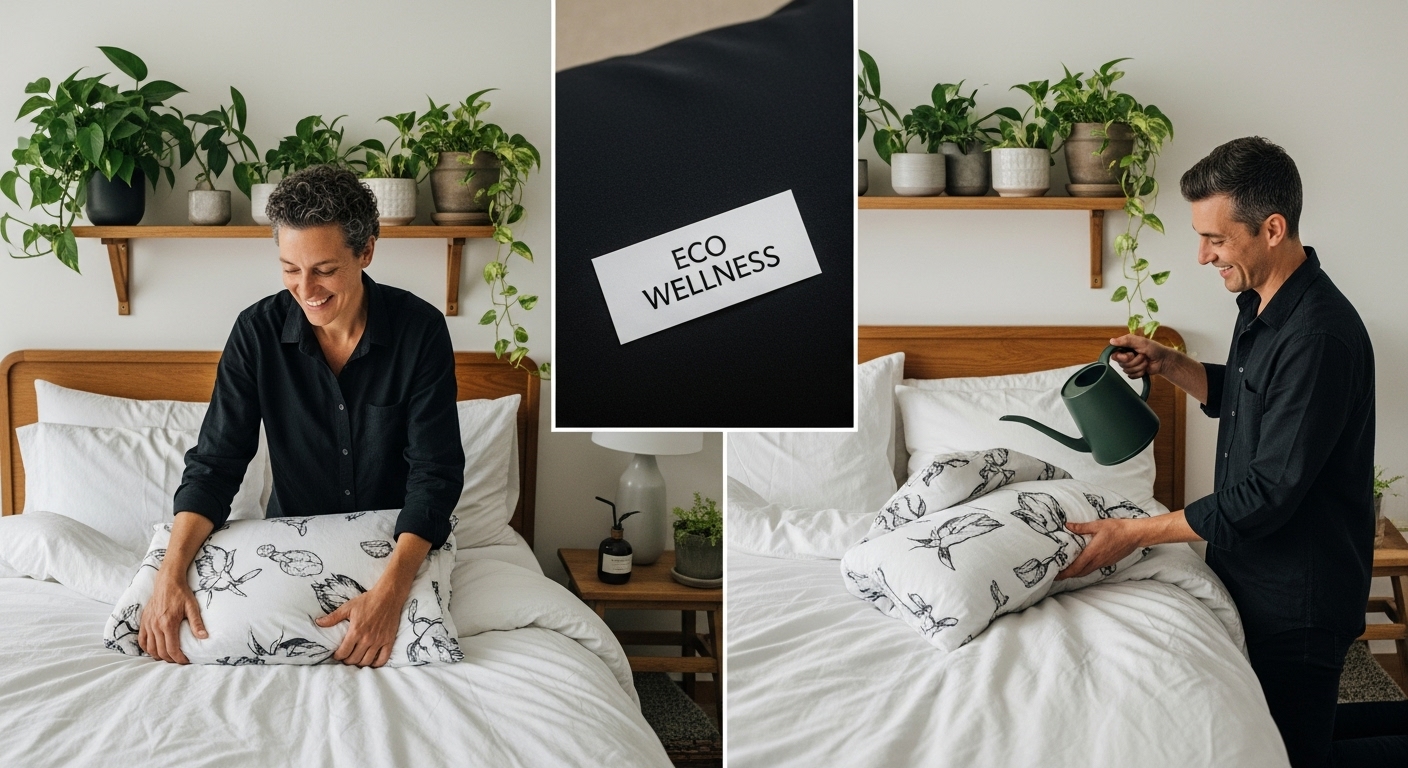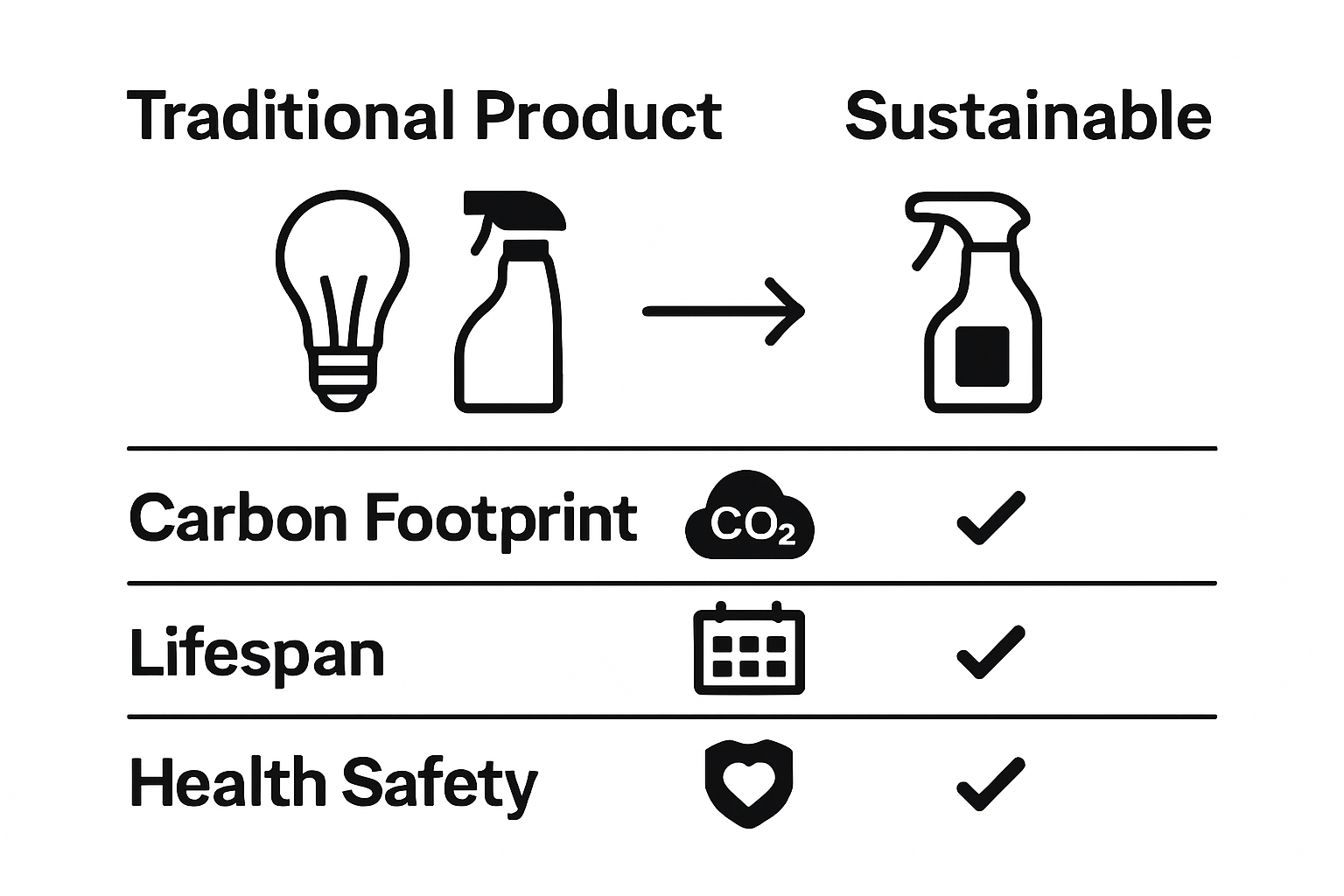Your Cart is Empty
Free Standard Shipping for Contiguous U.S. Orders!
Free Standard Shipping for Contiguous U.S. Orders!
Catalog

Understanding the Benefits of Sustainable Home Products
September 27, 2025 8 min read
Sustainable home products are changing the way people shop for their houses. Consumers are looking for eco-friendly options, and research shows energy efficient home products can cut annual utility bills by up to 30%. Most would think these green choices only help the planet, but the real surprise is how much they benefit your wallet and health at the same time.
Table of Contents
- Defining Sustainable Home Products: What Are They?
- The Importance Of Sustainable Home Products For Homeowners
- Environmental Impact: How Sustainable Products Help The Planet
- Health And Safety Benefits Of Using Sustainable Home Products
- Economic Advantages: Long-Term Savings With Sustainable Choices
Quick Summary
| Takeaway | Explanation |
|---|---|
| Choose eco-friendly materials for your home. | Opt for products made from renewable, recyclable, or biodegradable materials to reduce environmental impact. |
| Invest in durable, long-lasting products. | Sustainable items minimize frequent replacements, decreasing waste and saving money over time. |
| Lower your utility bills by 30%. | Energy-efficient sustainable products can significantly reduce your household energy and water expenses annually. |
| Prioritize products that improve indoor air quality. | Select non-toxic alternatives that help eliminate harmful chemicals, making your living space healthier. |
| Support responsible manufacturing practices. | By choosing sustainable goods, you promote ethical production methods and lower carbon emissions. |
Defining Sustainable Home Products: What Are They?
Sustainable home products represent a revolutionary approach to consumer goods that prioritize environmental responsibility, resource efficiency, and minimal ecological impact. These products go beyond traditional manufacturing practices by integrating principles of environmental conservation, ethical production, and long term sustainability into their design, creation, and lifecycle.
Core Characteristics of Sustainable Home Products
Sustainable home products are distinguished by several fundamental characteristics that set them apart from conventional alternatives:
- Environmentally Conscious Materials: Crafted from renewable, recyclable, or biodegradable resources that minimize environmental strain
- Low Carbon Footprint: Manufactured through processes that significantly reduce greenhouse gas emissions and energy consumption
- Durability and Longevity: Designed to withstand extended use, reducing the frequency of replacements and minimizing waste generation
Manufacturing and Production Considerations
The production of sustainable home products involves a comprehensive approach that considers environmental impact at every stage. Research from the Sustainable Packaging Coalition reveals that sustainable manufacturing practices can reduce waste generation by up to 40% and decrease overall resource consumption.
These products are typically created using methods that:
- Minimize water usage during production
- Utilize recycled or responsibly sourced materials
- Implement energy efficient manufacturing techniques
Moreover, companies committed to sustainability often prioritize transparent supply chains, fair labor practices, and minimal environmental disruption. Learn more about our commitment to sustainable home products and how we integrate these principles into our manufacturing process.
Ultimately, sustainable home products represent more than just an ecological choice they embody a holistic approach to consumer goods that respects planetary boundaries while delivering high quality, functional solutions for modern living spaces.
Below is a comparison table outlining the differences between traditional home products and sustainable home products, focusing on their materials, health impact, cost savings, and environmental effects.
| Feature | Traditional Home Products | Sustainable Home Products |
|---|---|---|
| Materials Used | Often non-renewable, synthetic | Renewable, recyclable, biodegradable |
| Chemical Exposure | May contain VOCs and other toxins | Non-toxic, natural, fewer allergens |
| Product Longevity | Shorter lifespan, frequent replacement | Durable, long-lasting |
| Utility & Operational Costs | Higher utility bills, more waste | Lower energy/water use, cost savings |
| Production Practices | Standard manufacturing, less transparency | Ethical, resource-efficient, responsible |
| Environmental Impact | Higher carbon footprint, more waste | Reduced emissions, minimal waste |
| Indoor Air Quality | Can decrease due to chemical off-gassing | Improved by reducing chemical pollutants |
The Importance of Sustainable Home Products for Homeowners
Sustainable home products offer homeowners a powerful opportunity to transform their living spaces into environmentally responsible environments while simultaneously delivering significant personal benefits. These products represent more than just an ecological statement they are strategic investments that impact financial, health, and environmental dimensions of household management.
Economic Benefits and Cost Savings
Homeowners who choose sustainable products experience substantial long term financial advantages. Research from the U.S. Department of Energy indicates that energy efficient home products can reduce utility expenses by up to 30% annually. These savings emerge through:
- Reduced energy consumption
- Lower maintenance and replacement costs
- Enhanced product durability
- Minimized long term environmental impact
Health and Wellness Considerations
Sustainable home products significantly contribute to improved indoor environmental quality. By eliminating toxic materials and reducing chemical emissions, these products create healthier living environments. Learn more about our commitment to sustainable home solutions and how they support residential wellness.
Traditional home products often contain harmful chemicals like volatile organic compounds (VOCs) that can negatively impact respiratory health. Sustainable alternatives prioritize natural, non toxic materials that promote cleaner indoor air and reduce potential health risks associated with synthetic manufacturing processes.
Environmental Responsibility and Personal Impact
By selecting sustainable home products, homeowners directly contribute to global environmental conservation efforts. Each purchasing decision represents a vote for responsible manufacturing, reduced carbon emissions, and sustainable resource management. These choices create a cumulative impact that extends far beyond individual households, supporting broader ecological preservation goals and demonstrating personal commitment to environmental stewardship.
Ultimately, sustainable home products empower homeowners to make meaningful choices that benefit their immediate living environment while contributing to global sustainability objectives.
Environmental Impact: How Sustainable Products Help the Planet
Sustainable products represent a critical strategy in combating global environmental challenges, offering a tangible pathway to reduce ecological footprints and mitigate climate change impacts. By reimagining product design, manufacturing processes, and consumption patterns, these innovative solutions provide meaningful interventions that protect and restore planetary ecosystems.
Reducing Carbon Emissions and Resource Consumption
Sustainable products directly contribute to greenhouse gas reduction through strategic design and production methodologies. Research from the Environmental Protection Agency demonstrates that sustainable manufacturing practices can decrease carbon emissions by up to 25% compared to traditional industrial approaches.
Key strategies for emissions reduction include:
- Utilizing renewable energy sources during production
- Implementing circular economy principles
- Minimizing waste through innovative design
- Selecting low carbon materials
Biodiversity and Ecosystem Protection
Beyond carbon reduction, sustainable products play a crucial role in preserving global biodiversity. Learn more about our commitment to environmental conservation and how sustainable material choices protect natural habitats.
By prioritizing responsibly sourced materials and supporting regenerative production techniques, sustainable products help protect delicate ecological systems. This approach minimizes habitat destruction, reduces chemical pollution, and supports the intricate balance of global ecosystems.
Long Term Environmental Restoration
Sustainable products are not merely about reducing harm they represent an active approach to environmental restoration. Through regenerative design principles, these products contribute to rebuilding ecological systems, supporting soil health, and promoting sustainable resource management.
Consumers who choose sustainable products become direct participants in global environmental healing, transforming individual purchasing decisions into collective environmental action. Each sustainable product represents a vote for a more resilient, balanced planetary future.
This statistics table organizes key research-based findings from the article about the benefits of sustainable home products, providing a quick overview of measurable impacts.
| Area of Impact | Statistic / Research Finding |
|---|---|
| Utility Bill Savings | Up to 30% annual reduction (U.S. Department of Energy) |
| Waste Generation Reduction | Up to 40% less waste during manufacturing (Sustainable Packaging Coalition) |
| Carbon Emissions Reduction | 25% less emissions from sustainable manufacturing (EPA) |
| Indoor Air Quality Improvement | Reduced VOCs, fewer allergens (NIH research) |
| Resource Consumption | Decreased through energy- and water-saving production methods |
Health and Safety Benefits of Using Sustainable Home Products
Sustainable home products offer far more than environmental advantages they represent a critical strategy for protecting human health and creating safer living environments. By eliminating harmful chemicals, reducing toxic exposures, and prioritizing natural materials, these products provide comprehensive wellness benefits that extend well beyond traditional consumer goods.
Reducing Chemical Exposure and Indoor Air Quality
Research from the National Institutes of Health highlights that conventional home products often contain dangerous volatile organic compounds (VOCs) that can significantly compromise indoor air quality. Sustainable home products counteract these risks through:
- Utilizing non toxic, natural material compositions
- Minimizing synthetic chemical interactions
- Supporting respiratory system health
- Reducing potential allergen exposure
Preventing Long Term Health Complications
Chemical laden traditional products can contribute to numerous health challenges, including potential respiratory issues, skin irritations, and neurological disruptions. Sustainable alternatives prioritize human biological compatibility, selecting materials that align with natural physiological processes.
Learn more about our commitment to creating safe home products and understand how material selection impacts personal wellness.
Holistic Wellness through Mindful Product Selection
Sustainable home products represent a proactive approach to personal and environmental health. By choosing materials that are responsibly sourced, minimally processed, and free from harmful additives, consumers can create living spaces that actively support physical well being.
Beyond immediate health benefits, these products contribute to a broader wellness ecosystem that recognizes the intricate connections between human health, product design, and environmental sustainability. Each sustainable product selection becomes an investment in personal and planetary health.

Economic Advantages: Long-term Savings with Sustainable Choices
Sustainable home products represent a strategic financial investment that transcends traditional consumer purchasing models. By prioritizing durability, efficiency, and resource optimization, these products deliver substantial economic benefits that compound over time, challenging the misconception that eco friendly alternatives are inherently more expensive.
Reducing Ongoing Operational Costs
Research from the U.S. Department of Energy indicates that sustainable home products can generate significant utility savings, reducing energy consumption by up to 30% annually. These savings manifest through:
- Lower electricity and water utility expenses
- Minimized maintenance and replacement costs
- Enhanced product longevity and performance
- Reduced resource consumption
Lifecycle Cost Analysis
While sustainable products might present higher initial investment costs, their total lifecycle economics demonstrate remarkable financial efficiency. Learn more about the economic benefits of sustainable home solutions and understand how strategic product selection impacts long term financial planning.
Traditional products frequently require more frequent replacements and consume greater resources, creating hidden economic burdens. Sustainable alternatives are engineered with advanced materials and design principles that prioritize durability, minimizing replacement frequency and associated expenses.
Strategic Financial Planning through Sustainable Choices
Consumers who embrace sustainable home products transform their purchasing decisions into sophisticated financial strategies. By selecting products designed for extended performance and minimal maintenance, individuals can create predictable, reduced household expense structures.
Beyond immediate financial advantages, sustainable choices contribute to broader economic resilience. These products represent investments in personal financial health, environmental sustainability, and long term resource management, offering a holistic approach to consumer decision making.

Upgrade Your Home With Lasting, Sustainable Solutions
Tired of short-lived, wasteful products that drain your wallet and impact your well-being? You have already learned how sustainable home products deliver cleaner air and reduce hidden costs. At Cozee Bay, you can put this knowledge into action with beautiful, durable bamboo home essentials designed for both peace of mind and sustainable living—all while embracing planet-friendly manufacturing and non-toxic materials.

Experience the difference with our premium bamboo paper towel dispensers and explore a variety of organizer solutions thoughtfully crafted for homes and commercial spaces. Enjoy free shipping, a money-back guarantee, and see why our customers trust us for eco-responsible alternatives. Curious how you can make your home healthier and more cost effective right away? Visit Cozee Bay and discover how our solutions bring your values to life. Start your journey to a safer, greener, and more efficient home before another day passes.
Frequently Asked Questions
What are sustainable home products?
Sustainable home products are goods designed to minimize environmental impact through the use of eco-friendly materials, energy-efficient production processes, and a focus on durability to reduce waste over the product’s lifecycle.
How do sustainable home products benefit homeowners financially?
By choosing sustainable home products, homeowners can reduce utility costs by up to 30% annually due to lower energy consumption and less frequent replacements, making these products a strategic long-term investment.
What health benefits are associated with using sustainable home products?
Sustainable home products often contain non-toxic materials that improve indoor air quality by reducing harmful chemicals and allergens, contributing to better respiratory health and overall wellness.
How do sustainable products contribute to environmental conservation?
Sustainable products help reduce carbon emissions and protect biodiversity by utilizing renewable resources, minimizing waste, and supporting responsible manufacturing practices, which collectively contribute to global environmental health.
Recommended
Leave a comment
Comments will be approved before showing up.
Subscribe
Sign up to get the latest on sales, new releases and more …

